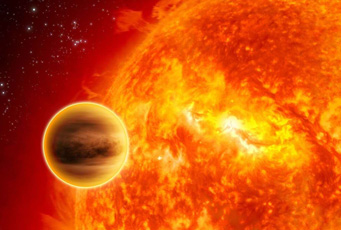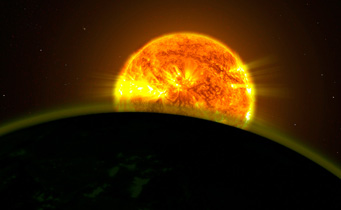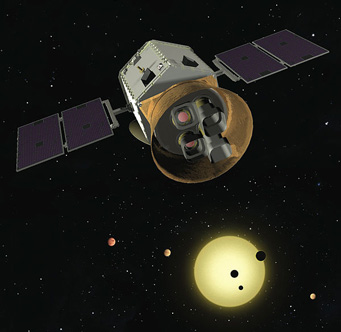Astronomers have come up with a new technique for measuring an alien planet’s mass, and therefore its composition and potential habitability, even when standard methods don’t work.
You’d never ask a woman her weight. (Actually, you’d never ask a man either.) But for exoplanets, the answer is crucial.

De Wit and Seager (both MIT) have found a new way to measure exoplanets' mass. For now, the technique is largely only useful for hot Jupiters, but future telescopes will allow them to scale the technique to nearby Earth-sized planets.
C. Carreau / ESA / Nature
Knowing the mass of an alien planet, along with its radius, tells astronomers whether the exoplanet is rocky, watery, or gaseous. In modeling, the mass can even influence whether the planet could host magnetic fields or plate tectonics. In the December 20th Science, Julien de Wit and MacArthur Fellow Sara Seager (both MIT) have found a forward-thinking technique to measure the all-important number.
To measure the mass of an alien planet dozens or hundreds of light-years away, astronomers usually watch for the star’s wiggle in response to the planetary tug. The wiggle comes from the fact that planets don’t actually orbit their parent stars — the star and planet orbit a mutual center of mass. So as the planet orbits, the star orbits too, albeit in a much smaller circle. (The mutual center can be inside the star itself, even if not at the core.)
Stellar wobble is easiest to see when massive planets orbit close to their parent stars, such as with hot Jupiters. But the punier the planet and the farther it orbits, the more weakly the star wobbles. And even if we could measure a star’s slowest sway, which we can’t yet (current telescopes can only measure a star’s velocity down to about 1 mile per hour), starspots and other activity on the star’s surface might cover up a planet-induced signal. That’s the case for hot Jupiter WASP-33, whose parent star pulsates strongly.
A New Way to Weigh Exoplanets
With some creative thinking, de Wit and Seager have found a new way to weigh an exoplanet: by watching it transit across the face of its parent star. When a planet transits, starlight passes through the thin sliver of its outer atmosphere. This passage imprints the starlight with the chemical fingerprints of the atmosphere’s composition. Astronomers collect this transmission spectrum during transit observations, measuring which wavelengths pass through the atmosphere and which are absorbed.

When an exoplanet transits across the face of its parent star, starlight passes through a thin sliver of its atmosphere. De Wit and Seager show how measuring the atmosphere's extent can give the planet's mass.
NASA Goddard Space Flight Center
De Wit and Seager determined that, because a more massive planet can collect a thicker gaseous shroud around itself, using these transmission spectra to measure the atmosphere’s extent could in theory also reveal the planet’s mass.
It’s not a clear-cut connection: the atmosphere’s extent also depends on its temperature (heat comes from the parent star and the planet itself) and the weight of its molecules. A hot Jupiter will have light molecules in its atmosphere, mostly hydrogen and helium. But a rocky planet’s atmosphere will be composed of heavier stuff such as oxygen, carbon dioxide, and nitrogen. De Wit and Seager show that they can calculate each of these parameters directly from the same transmission spectrum.
This isn’t just a theoretical exercise: the astronomers used the well-studied hot Jupiter HD 189733b to prove the technique works. Radial velocity had already shown the planet has a mass between 1.1 and 1.2 Jupiters; de Wit and Seager’s transmission spectroscopy calculations gave a mass of 1.15 Jupiters.
“This [technique] appears to be very promising,” says exoplanetary scientist Jonathan Fortney (University of California, Santa Cruz). “I think that in practice clouds will confound the technique a bit more than they suggest, but I think it will work a lot of the time.”
Scaling Down

The TESS satellite will monitor bright, nearby stars for transiting exoplanets. Though its focus is Sun-like stars, it will also catch some 10,000 M dwarfs in its view.
TESS team
For now, hot Jupiters remain the main target for the new technique. Their puffy, extended atmospheres make them good targets for transmission spectroscopy. But de Wit and Seager aim to describe super-Earths and Earth-size planets. Current telescopes can’t take transmission spectra of these smaller words, but the upcoming James Webb Space Telescope could. Scheduled for launch in 2018, it will be able to weigh Earth-size planets orbiting the coolest M dwarf stars up to about 160 light-years away. Its reach will extend twice that far for super-Earths.
Unfortunately, that means Kepler’s 167 confirmed exoplanets and 3,500 candidates will be largely out of reach.
“You wouldn't be able to do this for stars in the Kepler field, which are too far away and faint,” Fortney explains. “But Kepler wasn’t designed to find planets around bright stars that would be amenable to atmospheric characterization.” Instead a number of upcoming projects, including SPECULOOS and TESS (launching in 2017), will focus on finding planets orbiting nearby stars, whose atmospheres will be easier to study.
The ultimate goal. says de Wit, is to combine all the available data for an exoplanet — including both the wobble of its star and the extent of its atmosphere — to better estimate its mass and understand its atmosphere . The more tools in astronomers’ toolbox, the better, because it’s not enough to just count exoplanets anymore, it’s time to see what they’re made of.
 2
2
Comments
Robert Casey
December 19, 2013 at 4:24 pm
Yhis method may get confused if it was looking at a planet like Venus. And an Earth, which is more massive, but has a much thinner atmosphere.
You must be logged in to post a comment.
Monica Young
December 20, 2013 at 7:56 am
Robert, that's an excellent illustration of the issues discussed in the article - an atmosphere's extent depends on mass, but it also depends on the atmosphere's temperature and the weight of its molecules. Venus's atmosphere has heavier molecules (it's carbon-dioxide-based, whereas Earth's atmosphere is nitrogen-based), and it's hotter too, three times hotter than Earth's atmosphere. So the vertical extent of its atmosphere is almost twice that of Earth's even thought they have the same mass. The authors of the study point out that transmission spectra can get at all three numbers (mass, atmospheric temperature, and molecular weight) directly.
You must be logged in to post a comment.
You must be logged in to post a comment.